When I was younger, I really loved lists of great comics. It was a good way to get some leads on good stories.
One of these came from the magazine Comics Buyers Guide, which celebrated its 1600th issue (as well as the publication of the 160,000th comic book in North America) in December 2004 with a list of 1600 Comic Books You Need to Have! It's worth noting that it's not officially a best of list. They call it other things.
- 1600 Comics you need to read!
- 1600 Comics worth every penny!
- 1600 Comics you want to have!
- 1600 Comics as good as it gets!
- 1600 Comics we all should own!
- 1600 Comics you'd better get!
- 1600 Comics for that desert island!
- 1600 Comics better than the rest!
In the years since, I've used it for recommendations. But in the last few years, I just haven't been reading all that many comics, so I figured that trying to read through as much of it as possible would be a nice challenge, to read and reread some decent comic books. I tried last year to keep track on another site, but I figured I'd go for it here.
The comics, which do not appear to be listed in any particular order are...
- Fantastic Four #36-52, Annual #2-3
- Cosmo the Merry Martian #1-6
- Amazing Fantasy #15, Amazing Spider-Man #1-50
- Dark Horse Presents #51-62 (Frank Miller's Sin City)
- JLA #1-4
- Captain Marvel Adventures #22-46
- Bone #1-55
- League of Extraordinary Gentlemen #1-6
- Daredevil #1-11
- Acme Novelty Library #1-15 (Jimmy Corrigan)
- Solar The Man of the Atom #1-12 (Valiant)
- Superman Volume 2 #71-82, Action Comics #680-691, Adventures of Superman #494-505 (The Death & Return of Superman)
- Our Gang With Tom and Jerry #46-57
- Ranma 1/2 Part 1 #1-7
- Captain America #100-111
- Megaton Man #1-10
- Dynamo #1-4
- Flash #129-139
- Crisis on Infinite Earths #1-12
- Akiko #1-18
- American Flagg! #1-26
- Raggedy Ann & Andy #1-39
- Avengers #115-118, Defenders #8-11
- All-Star Comics #34-38 (1947)
- Zot! #30-36
- Adventures of Peter Wheat #1-35
- Powers #1-6
- Mad #1-23
- Miracleman #1-16
- Normalman #1-12, Annual #1
- Leave It to Chance #1-12
- The Authority #1-12
- Usaji Yojimbo Volume 3 #13-22 (Grasscutter)
- Donald Duck Four Color Comics #9, #29, #62, #108, #147, #159, #178, #189, #199, #203, #223, #238, #256, #263, #275, #282, #291, #300, #308, #328, #339, #348, #367, #408, #422
- Marvels #1-4
- New Teen Titans #39-44, Annual 3 "The Judas Contract"
- Ash Volume One #0, 1-6
- Ms. Tree #10-55
- Lone Wolf and Cub Volumes 1-28
- Anthro #1-6
- Strangers in Paradise Volume 1 #1-3, Volume 2 #1-14
- The Incredible Hulk #1-6
- Superboy #89-100
- Thirteen Going on Eighteen #1-29
- Justice League of America #100-102, 135-137
- From Hell #1-11
- Amazing Spider-Man #68-77 (Tablet of Time)
- Stray Bullets #1-5
- Batman #608-619
- Magnus Robot Fighter #1-21 (Gold Key)
- Green Arrow #1-10 (Kevin Smith/ Phil Hester)
- Hate #1-15
- Uncle Scrooge Four Color Comics #386, #456, #495
- Avengers #167-168, 170-177 (Korvac Saga)
- X-Men #111-142
- Sandman #19-28
- Groo the Wanderer #1-42
- Deathlok #1-4 (1990)
- Animal Man #1-5
- Concrete #1-10
- Inferior Five #1-5
- Batman: The Dark Knight (Returns) #1-4
- Aliens VS Predator #1-4
- Truth: Red, White and Black #1-7
- The Spirit January 4 1948- December 25 1949
- Little Lulu Four Color #74, #97, #110, #115, #120, #131, #139, #146, #158, #165
- Legion of Superheroes #290-294, Annual #3
- Avengers #89-97 (Kree-Skrull War)
- Superman #146-169
- Elfquest #1-21
- Squadron Supreme #1-12
- Haunt of Fear #19-28
- Batman #404-408 (Batman Year One plus one issue?)
- Ultimates #1-13
- Action Comics #507-508, 510-512 (Return of Jonathan Kent, the Superman/ Lex team)
- Fightin' Army #75-92
- Adventure Comics #340-355
- Silver Surfer Volume 1 #1-7
- Airboy Comics Volume 5 #11-12
- Oz-Wonderland Wars #1-13
- Conan the Barbarian #1-21
- Camelot 3000 #1-12
- Marvel VS DC/ DC VS Marvel #1-4
- Thor #337-340
- Sugar and Spike #1-33
- Flash #95-100 (Terminal Velocity)
- Astonishing Tales #25-28, 30-36
- Cerebus #1-50
- The Man of Steel #1-6
- Boys' Ranch #1-6 (Simon/ Kirby)
- Green Lantern Volume 2 #76-87, 89
- Supreme #41-52B
- Swamp Thing #20-64
- Age of Bronze #1-16
- Astro City Volume 1 #0-6, Volume 2 #1-22
- Watchmen #1-12
- Animal Comics #1-30
- Marvel Super Hero Contest of Champions #1-3
- Justice League of America Volume 1 #9-22
- Invisible People #1-3
- Classics Illustrated #1-27
- Detective Comics #327-328
- Kingdom Come #1-4
For my tally, I'm going to have to add this up, and there are some unresolved questions. Does the Spirit count under the Kitchen Sink reprints (roughly 25 issues) or is each weekly instalment one comic, which is closer to 100? The numbers don't seem to all add up either way, which is going to make efforts to tally these books convoluted.
Obviously, there are some major exclusions. It's not meant to be some official list of greatest comics. It's essentially varied recommendations from comics fans. It's credited to the CBG review gang, plus Craig Shutt and Andrew Smith.
There are some minor errors. Captain America #100 seems arbitrary for an opening as it concludes a storyline that began in Tales of Suspense. Solar #12 is part of the Unity crossover, so it seems more logical to cut off the run at #11. They seem to include the entire Death & Return of Superman arc without the Man of Steel issues, to say nothing of annuals or tie-ins in other titles. Why cut off the Lee/ Kirby Fantastic Four at Part 1 of the story introducing Black Panther?
One rule I'm making for myself is that if something is included for the sake of one story (IE- the Sin City issues of Dark Horse Presents) I'm still going to read the rest of the stories in those issues.
Results 1 to 15 of 18
-
08-12-2023, 05:58 AM #1
 Comic Buyer's Guide 1600 Comic Books You Need to Have!
Sincerely,
Comic Buyer's Guide 1600 Comic Books You Need to Have!
Sincerely,
Thomas Mets
-
08-12-2023, 06:01 AM #2

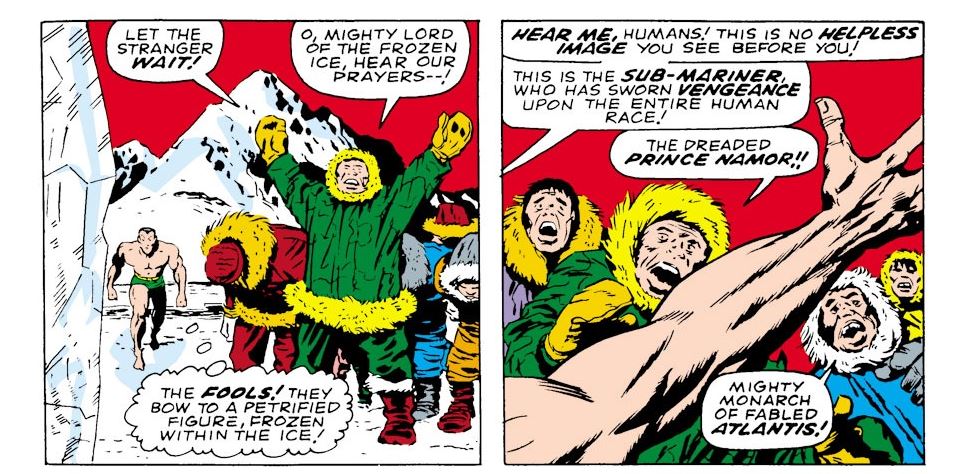
Captain America #100: It seemed a little odd to include this as the first of twelve Captain America issues, as it is the conclusion of a story that kicked of Tales of Suspense (for a while, Marvel published anthology titles with two heroes sharing a monthly title, this may have have been due to a publishing contract with associated of DC Comics so Cap had ten pages a month and Iron Man had another ten in the same book) although Lee and Kirby do make sure to reference the character's backstory in an opening flashback sequence. Then we get a decent story about Captain America realizing the Baron Zemo agent trying to kill him is his SHIELD agent girlfriend on an undercover mission.
An optimistic scene has Black Panther take off his mask to convince Baron Zemo's men to surrender. This is probably not how Nazis will respond to learning that the masked man who defeated man is an African Prince, but it's nice that the Marvel universe is one where that kind of stuff happens.
Grade: A
Captain America #101-104: This is a rather unfocused Red Skull story almost split into three adventures, as a long-lost robot "the fourth sleeper!" awakens, Cap fights an island of exiled Nazis and the Red Skull attaches a nuclear bomb to him. Kirby gets some good stuff to draw, and Red Skull remains one of the nastiest Silver Age Marvel villains, possibly second to Doom, although I have preferred the other Lee/ Kirby Red Skull stories, as well as the follow-up saga with Gene Colan.
Grade: A-
Captain America #105: And after the Red Skull saga, we mainly get a series of single issue stories. While there are still some multi-part Marvel stories at the time, it does appear there's an emphasis on one-off stories, perhaps with the expansion to more monthly titles. This one is kind of intense, as Cap fights three B-listers to save New York from nuclear annihilation. And the story opens with a World War 2 flashback just for the hell of it. I read a review of the final Lee/ Kirby Cap issues that described it as an example of Marvel's grandiose years, and these issues certainly are Silver Age Marvel at its most larger than life.
Grade: B+
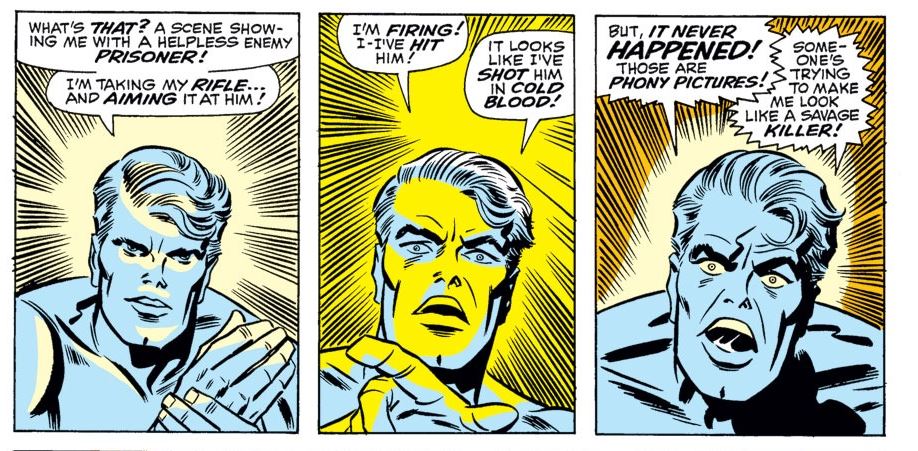
Captain America #106: This is a bit of an oddball story as film producers are paid by Communist China to fabricate material in which Cap commits war crimes, as part of an effort to ambush him into a fight with a Life Model Decoy that looks just like Steve Rogers, which will later be used to further frame him. I'm not sure they get much out of that duality, but this issue remains a highlight of Silver Age Marvel just due to Kirby's oddball art when given a conspiracy plot involving movie sets, and the relatively sympathetic motivations of the bad guys, producers trying to make art and seeking money for an operation to save a family member.
Grade: A
Captain America #107: This one-off is a bit derivative of other stories where someone tries to convince a hero he's going insane (Lee/ Ditko Amazing Spider-Man #24 might just be the best version of that story) but Doctor Faustus does go on to be a recurring villain, the details of the conspiracy are dramatic, and all the nightmares lead to some great visuals for Kirby.
Grade: A-
Captain America #108: In this issue, Lee and Kirby seem to remember ongoing storylines revealing where Cap's girlfriend is, and seeding the next encounter with the Red Skull. The bad guy is the Trapster, and it is a bit hard to take seriously. But it is Kirby, so it looks fantastic.
Grade: B+
Captain America #109: This retelling of Cap's origin was chosen as one of fans' favorite Marvel comics ever. I suspect that was somehow a proxy vote for Captain America Comics #1, as somehow no golden age comics made the list, which was biased towards historically significant comics. That said, it is a great comic book, with Kirby at his best, showing off World War 2 Action, and weirdo science experiments. If fans did really vote for it, I credit their good taste.
Grade: A+
Captain America #110-111: Jim Steranko arrives with some of the most innovative comics work ever. Cap has an okay story where he tries to take Rick Jones on as a partner, and struggles to overcome the trauma of losing Bucky, but it's more about the inventive sequences. Madame Hydra immediately becomes a major Marvel villain. There is a plot to have Steve Rogers hide his secret identity which seems unnecessary, but when the visuals are so imprressive, I don't mind too much.
Grade: A+
Most of these stories are reprinted in Marvel Masterworks Captain America Volume 3 (It doesn't include #100, but does include #112's Jack Kirby recap fill-in issue and 113's conclusion to Steranko's Madame Hydra saga.) An extra in the Marvel Masterworks reprint is Steranko's commentary where he goes into detail about his innovative techniques (the man is not humble, but it's interesting.) The grade for that, in the context of it having a $17 cover price on Comixology, is A.
Issues So Far: 12/1600Sincerely,
Thomas Mets
-
08-12-2023, 06:05 AM #3


The Man of Steel #1
An unusual choice with the mini-series is that every issue is a single issue story. For the most part, the run does consist of shorter arcs, either single issues or two-parters. It's an interesting decision by a writer/ artist I have generally seen as willing to tackle longer stories. In the introduction to the first Man of Steel trade paperback, Byrne does associate Superman with multiple stories per issue. This could be why the first issue is also split into several sections.
One of the biggest changes was the sterile futuristic world of Krypton where children are conceived in gestation chambers, and it's normal for them to not know the touch of a parent. I get the argument for this take, but I'm not a fan. Still the prologue is a decent sci-fi story as Jor-El makes a major discovery about himself in the last moments of Krypton.
Chapter One is set in Smallville as Pa Kent tells eighteen year old Clark where he came from. It's economical, and does have an ideal setup for Superman's family life, so that he has two living parents in Kansas to contrast with his life in Metropolis. His parents are pretty effective as a moral conscience for the most powerful man on Earth, although other versions of this type of scene function more effectively, as it makes more sense for Superman to learn of his alien origins before he learns of his amazing powers or immediately after. Here he's not only a star high school football player when he sees the craft his parents found him in, but he's had X-ray vision and flight for a while.
Chapter Two is set a few years later, as the world has learned about Superman. This is probably the best sequence in the issue. It's a rescue scene we've seen a lot (Superman saving people on an experimental rocket) but it also represents a point of no return for a character who has tried to keep his existence secret, but had to make the decision to reveal his existence in order to save lives.
Byrne is able to pull off one of the most important superhero scenes, the decision to adopt a secret identity. There are small details that sell it, like his parents helping him come up with an iconic uniform, or even the decision to hide the idea that he has a secret identity, so that the public would have no reason to suspect that Clark Kent is Superman any more than they would guess that Clark Kent is secretly Tom Cruise.
One interesting twist here is that they're not sure where Superman came from yet, which allows more discoveries about Krypton to be an effective story engine. It also reflects the national paranoia at the tail end of the cold war.
This was meant to be the definitive take on Superman, and it falls short of that. But it's an okay beginning to John Byrne's take on the character.
B+
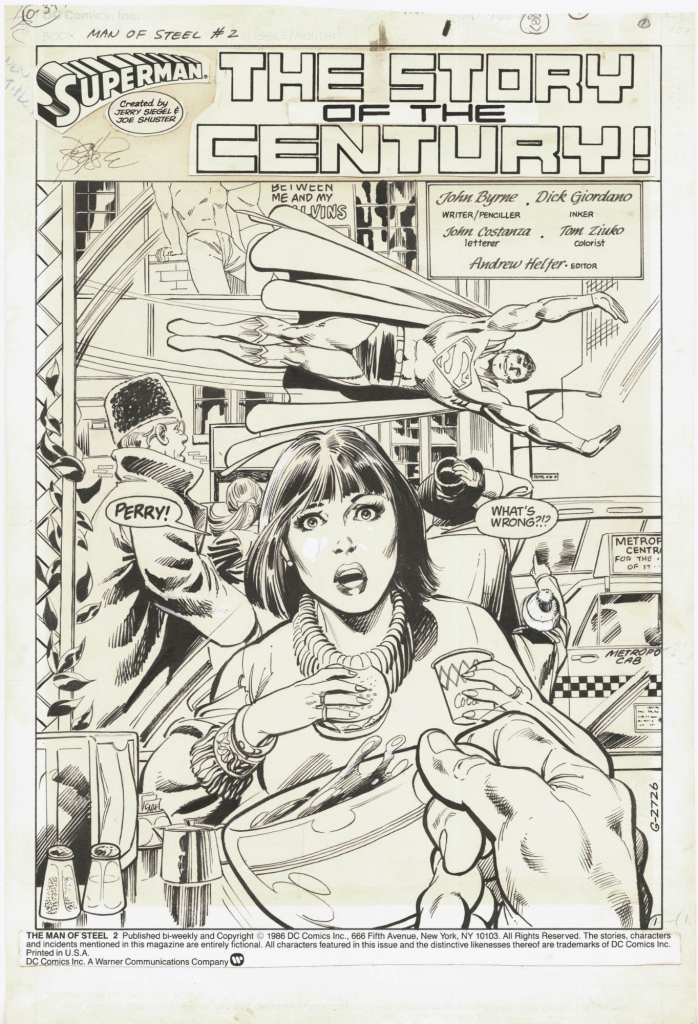
The Man of Steel #2
With the second issue we may have the best sense of what John Byrne's up to. It's a relatively standalone story from Lois Lane's perspective as she's trying to learn more about Superman. Obviously it's 22 pages, but there's a bit of Will Eisner's The Spirit here, with an issue that is self-contained but part of a larger overall story that also happens to be formally creative.
Continuity-wise, the most important thing that happens here is the introduction (a cameo here) of a new version of Lex Luthor. He's not a mad scientist; he's a businessman. This is a major revision of an A-list supervillain that has come to define subsequent appearances, including his depictions in the Fox/ WB animated cartoon, the Smallville series and the Zack Snyder films.
There's a great scene where Superman grabs a purse-snatcher, and mildly chastises his victim for her loud boombox. That's followed up with a hostage switch, which is pretty much Superman's debut to the Metropolis PD.
It's an excellent Lois Lane spotlight, including the twist at the end. It's pretty clear from the interactions between Superman and Lois that Byrne is a fan of the Richard Donner/ Christopher Reeve/ Margot Kidder film. It's a fun exchange. It sells Lois' gumption, and hints that Superman really gets her.
A+
The Man of Steel #3
This is an unconventional chapter in what is supposed to be Superman's origin story. It seems to be much more of a Batman comic. It's set in Gotham, and the bad guy is more of a type who would fight Batman (and who has reappeared in the Batman comics) who is also defeated through detective work. On the other hand, this story also doesn't feature Batman supporting characters, and is part of Superman's larger character arc, as he realizes that some places are different from what he's used to. It seems like a pilot for Byrne's decision to focus on team-ups in Action Comics. You could probably remove this issue from The Man of Steel and it wouldn't make much of an impact on the narrative (arguably Superman #1 connects more to what's going on in Man of Steel by paying off some of the set-up.)
This issue features one of the most important moments in post-crisis DC: the first encounter between the top two heroes, and it's a worthy effort. Byrne has some fun with readers' uncertainty. This version of Batman and Superman have never met before, so when Superman tries to get Batman arrested as a violent vigilante, it's plausible. And when Batman says he has a bomb attached to an innocent person Superman listens (this plot point has a satisfying conclusion.) I like the differences in their viewpoints. The adversarial relationship isn't something that should stick around forever, but it works in this story.
One really good minor scene is when Superman shows up, and a henchman decides to just leave rather than fight a guy who just punched through a solid wall.

Grade: A
I can appreciate that The Man of Steel may be a different read for someone who was a fan of bronze age Superman and/ or was expecting the definitive take on the character. I've got more distance at this point. Cards on the table, I've learned to appreciate the bronze age Superman more, and I would rate the best stories (Alan Moore's work; the most acclaimed Cary Bates/ Curt Swan collaborations) higher than most of the acclaimed post-Crisis Superman material, but this is not a bad take on the character. I get that people will feel differently if this essentially replaced their favorite version. For me, these are back issues I could read alongside Morrison/ Quitely's All-Star Superman, or Superman VS Mohammed Ali, as opposed to the only take on Superman at the newsstand.
When I was in middle school rereading my TPB of The Man of Steel, I was really excited to learn that John Byrne was going to be doing the same thing to Spider-Man with Chapter One. That did not work out well.Sincerely,
Thomas Mets
-
08-12-2023, 06:09 AM #4

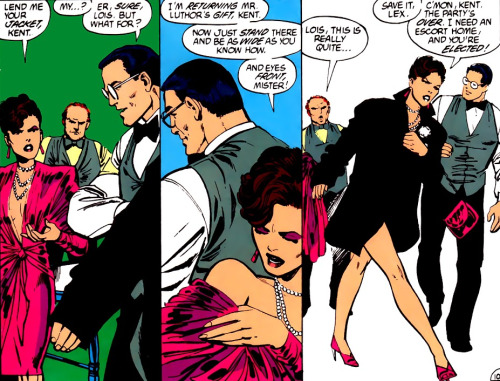
The Man of Steel #4
A major highlight of the Post-Crisis relaunch is the new take on Lex Luthor of a billionaire who was the most important man in Metropolis before Superman showed up.
One minor scene I really liked is where Clark has to shave an unusual way, especially so that Lois Lane in the next room doesn't know what's going on. We get a sense of how easy it would be for him to slip up, and for someone else to realize his secret.
There is some stuff here that doesn't make sense. Clark seems quite ignorant of Lex Luthor, even though he has been in Metropolis for a year and half. Granted, Luthor's been away, and in the context of 1980s comics there has been a high amount of set-up. The history the characters that just doesn't seem to match the comics. This doesn't feel like a Clark Kent who has been coworkers with Lois for a year and a half, and in love with her the whole time. It's a minor downside with the single issue format, especially as the one issue set during that year and a half was set in Gotham City. It seems like a waste that they didn't explore the dynamic of Superman in Metropolis before Lex Luthor throws a wrench in things, although that's more about if they had structured other issues differently than anything to do with these 22 pages.
And these 22 pages are good. The confrontation between Lois and Lex is a highlight. It gets to her personality, shows off Byrne's storytelling skills, and I like the detail that Lex Luthor basically wants to possess Lois Lane.
The Man of Steel is essentially a checklist of important Superman moments. And Byrne sells two more pretty well, with Lex Luthor getting humbled by Superman for the first time, and deciding that it's time to show who's boss.
Grade: A

The Man of Steel #5
This one introduces the post-Crisis Bizarro, or at least the first of the them. We lose the "Me Am Bizarro" charm, although that remains something that can be done in the future, since this story is more of a prototype. It does create an unusual challenge for this Superman, as he's pit against someone with his powers for the first time, and has to be worry about keeping his secret identity safe. The unliving, barely comprehending Bizarro here is still creepy and tragic.
The main story adapts elements of a Silver Age Bizarro story in Superboy #68, with Bizarro's interactions with a blind girl. Here, the blind girl is Lois' flight attendant sister, injured in the aftermath of a terrorist attack. I'm not sure I should count this it against this issue that it was never brought up again, or that we never got to see that story. It sounds potentially interesting. Her histrionics over her disability are extreme, and there are some troubling implications about the message for the handicapped, although I can understand it as the story of one particular woman, whose sister is also capable of extreme behavior.
Lex Luthor has been trying to copy Superman for two years, so more time has passed. If this mini-series is supposed to cover the first five years of Superman, a format of done in one adventures might not be the best choice. It's starting to feel like random back issues from a much longer run. It does provide some territory for other projects to explore, although it takes a while (Superman For All Seasons is an obvious highlight) for others to cover the adventures of the more inexperienced Superman.
Grade: B+

The Man of Steel #6
This issue is a bit of a Smallville spotlight, and there's a good sense of a familiar lived-in community, with a very different sensibility from Metropolis. This issue highlights how Superman has two home bases, and there are some nice details (Clark going to the kitchen to grab rhubarb pie as a midnight snack, Clark mingling with people arriving on a bus from Metropolis so that no one asks he got to Smallville.) And then the story starts.
The main thing that happens is that Superman has a vision of Krypton, and gets his first understanding of where he came from. There's a nice point where Pa sees Jor-El's ghost appear to hurt Clark, and goes to save him, but it's mostly anticlimactic. Usually Byrne nailed the big moments, but this is an exception, and raises weird questions. If Superman knows everything about Krypton, shouldn't that be shared with scientists, anthropologists, and so on? The secrets of Krypton could be something to explore later, but it's dispensed with so quickly.
This issue also brings back Lana Lang, revealing that she's been traumatized by the discovery that her high school boyfriend had superpowers, and wasn't all that interested in a life with her. This is another big moment that Byrne doesn't sell very well. I don't think it's inherently a bad idea, although ten years after Clark became Superman might be the wrong place for the story, and it's already a crammed done in one with Clark discovering Krypton, and Pa Kent trying to save the day. This requires nuance, subtlety and psychological depth, and we don't really get it here.
The issue ends anticlimactically with Superman mulling things over by himself. There's a mystery that will be resolved in Superman #1, which helps make the mini-series seem even more incomplete.
I can understand some of Byrne's decisions here. He started it with Smallville and Krypton, so he ends things that way. This is a big moment for Superman, as he realizes that he considers himself human. There are some story engines from the future, with Superman's awareness of his Kryptonian origins, and a tenuous renewed friendship with Lana Lang. It just feels perfunctory, as if Byrne wanted to get the character growth out of the way.
I'm conflicted on the grade here. Usually, I'm an easy grader, looking at things like craft and storytelling. So on that level this would be a B. However, there's something to be said for missed opportunities, and how others would be limited from featuring these big moments because of how Byrne chose to introduce the Post-Crisis Superman. I could understand a D grade. I'll average it out.
Grade: C
Overall Grade for The Man Of Steel: B+
This probably wasn't the best way to introduce a new Superman, but the storytelling is pretty good, and in other issues, Byrne lands quite a few of the big moments.
I covered the first eight issues of Alan Moore's run on Swamp Thing in a different thread.
Issues So Far: 26/1600Sincerely,
Thomas Mets
-
08-12-2023, 06:12 AM #5

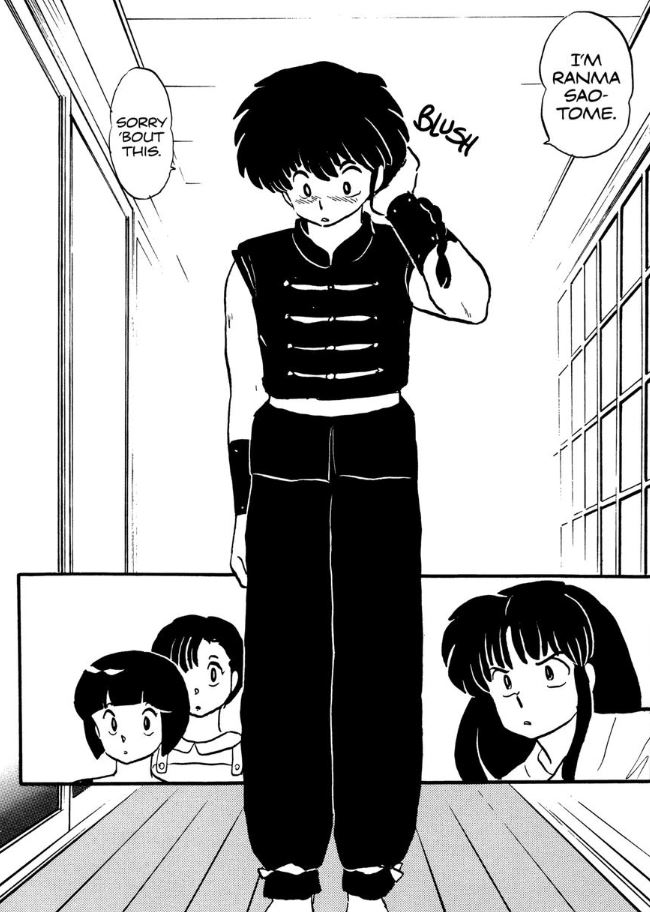
Ranma 1/2 Volume 1 #1-7
This manga had a great concept, although it's probably troublesome now. A teenage karate master is cursed to turn into a girl every time he is exposed to cold water (hot water turns him back.) I haven't read it in years, but it's a fun high school action comedy. I recall later stories being better, although it is a manga notorious for a lack of character growth, and there are more developments in the early chapters.
Detective Comics #327-328
These two issues seem to represent when Batman (and Elongated Man) hit the Silver Age. They're fun, playing around with expectations like when Elongated Man goes to a new city and no one knows who he is, or hoodlums all recall how Batman and Robin put them and their pals in jail. It marks an evolution from the Golden Age Batman without the ridiculousness of what Silver Age Batman is known for.
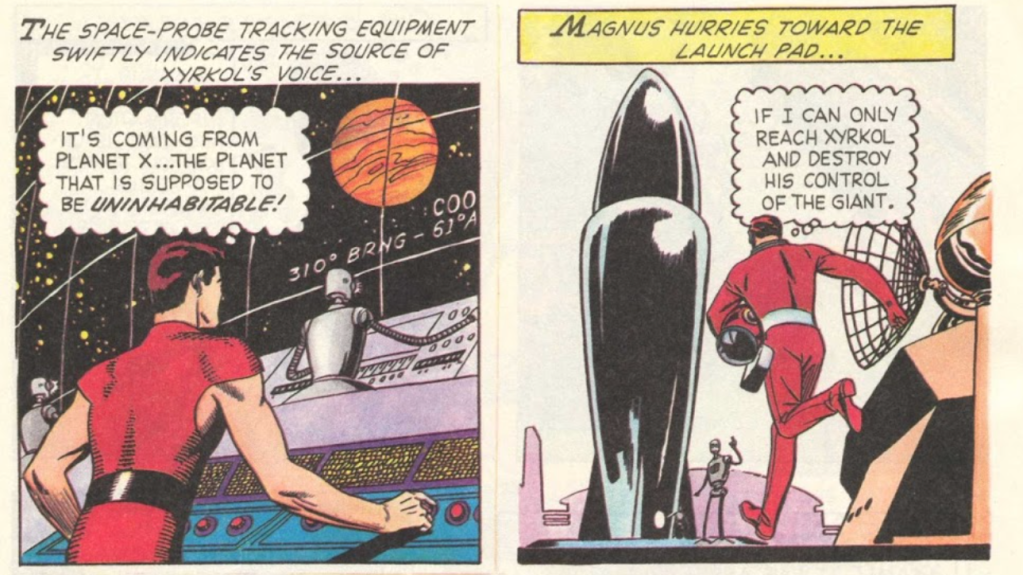
Magnus Robot Fighter #1-3
The versions I read were reprinted by Valiant as Original Magnus, Robot Fighter and Vintage Magnus, Robot Fighter and if you see these in dollar bins, I highly recommend it. Russ Mannings' vision of the future is lovely, and the recoloring is excellent. These are accessible, clean sci-fi adventure stories, following a guy who is kind of a superhero of the 40th century in a world where humans are overly reliant on robots and some of them are doing bad things. There may be diminishing returns later (I may very well be wrong about that), but I'm glad I sampled this.
Comics Read So Far From the List: 38/1600Sincerely,
Thomas Mets
-
08-12-2023, 09:22 AM #6

During summer vacation, I've been able to read much of the Bone omnibus. I'll look at in terms of the trade paperbacks.
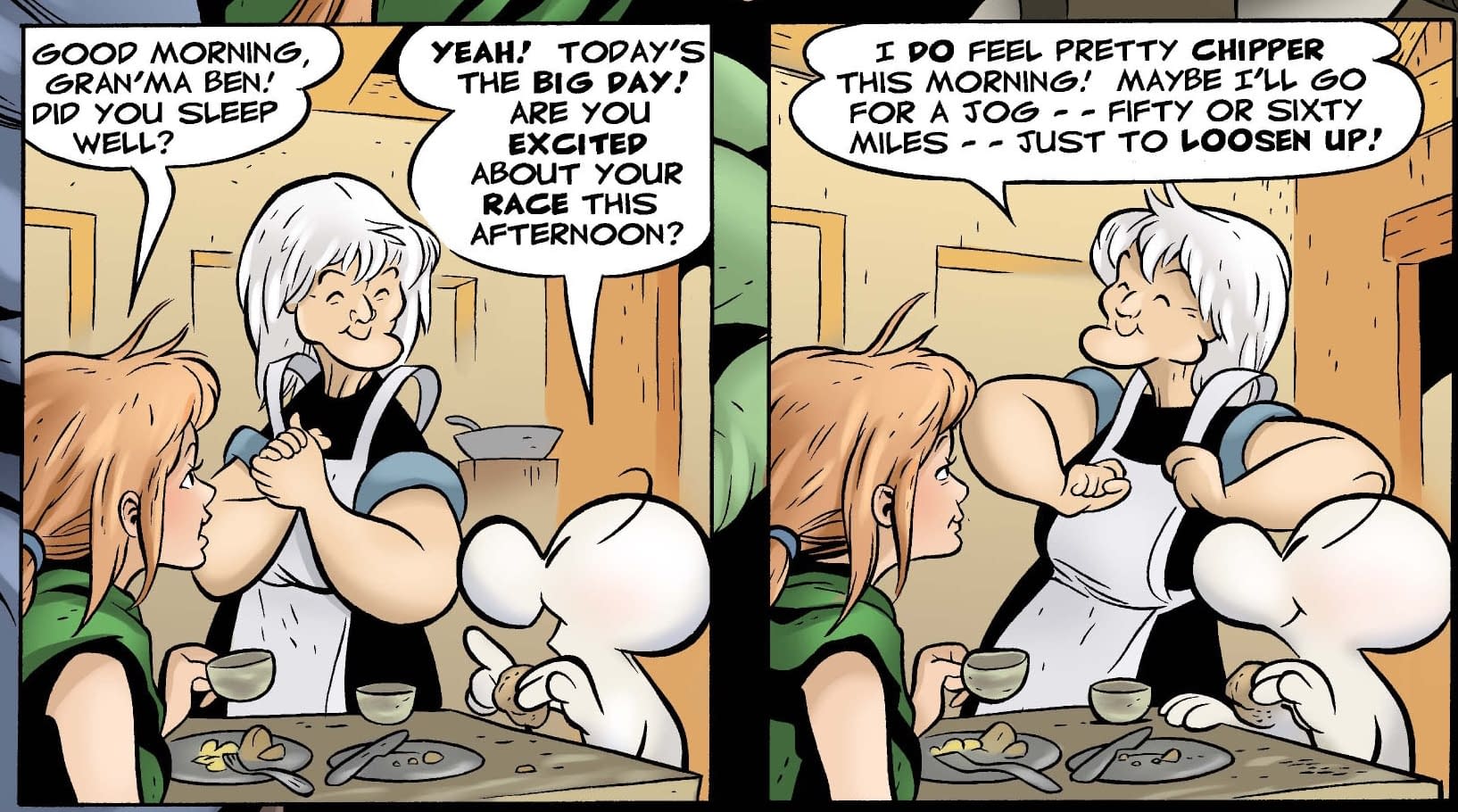
Bone #1-6
These are generally lighter stories in a fantasy world with Fone Bone in an unfamiliar land searching for his cousins. It's a great set-up and one of the most accessible comic books. I get why it became a monster hit.
A
Bone #7-11
The highlight of Bone might be its first big story, with the legendary Great Cow Race. It's just one of my favorite comic book stories ever.
A+
Bone #12-19
The story makes it transition from a cute animal series to a fantasy epic with a clear beginning, middle and end. The worldbuilding is solid, but it loses a bit of its charm.
A-
Bone #20-27
When Bone came out every other month, I could understand fans being frustrated with it (and why it's so successful after it was finished and fans could binge-read it. This story of Phoney doing something sketchy goes on a bit long, although it has decent payoff and some great scenes.
B+
Bone #28-32
In this section, the heroes are separated, and get into a conflict with a powerful mountain lion, who makes sense as a major player. It's a bit padded, but the challenge does work, and I don't mind if it's padded when the entire series is less than 40 bucks as a compendium.
A-
Bone #33-37
We meet the bad guy and finally get some big secrets. It's not perfect, but even when it gets into the mythos that aren't the reason for the series' popularity, it's so fun to read.
A-
Comics Read So Far From the List: 75/1600Sincerely,
Thomas Mets
-
08-12-2023, 04:30 PM #7

Wow, great list! I've read many of those over the years but I don't think I've even read half of all of that
-
08-16-2023, 09:41 AM #8

I read the Tablet of Time Spider-Man story.
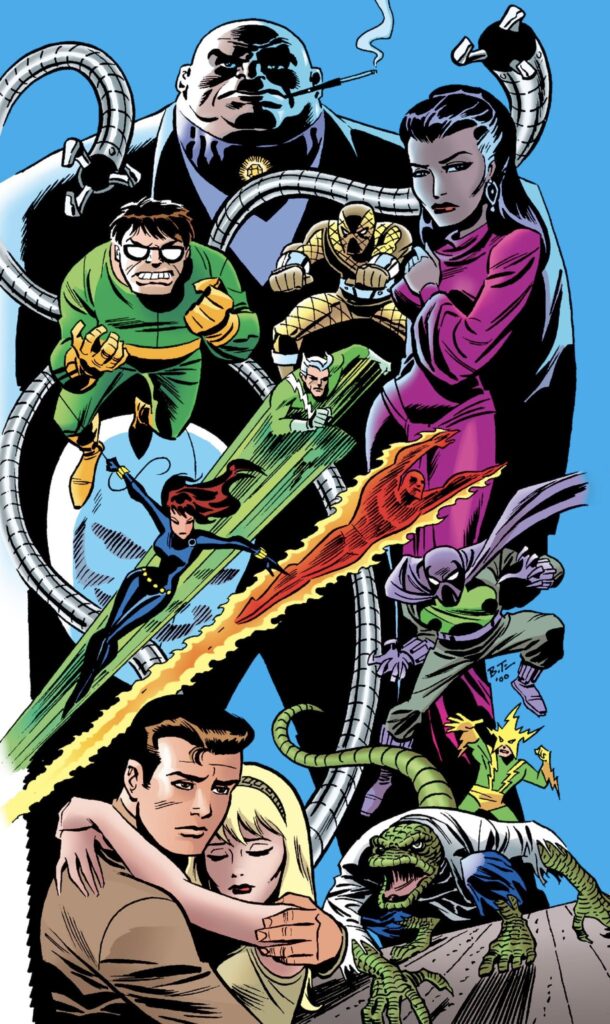
Amazing Spider-Man #68-70
It starts out pretty well. Say what you will about Stan Lee, he was head and shoulders above his contemporaries when it came to melodrama and characterization. The Kingpin’s reintroduced beating the holy hell out of some of his henchmen in a workout ritual. Aunt May’s sick from the previous issue and claims to cheer up by seeing Peter happy with Gwen. Then it turns out that she doesn’t want to ruin their mood by revealing how bad it is. Randy Robertson makes his appearance, so even at this point in the run, we still have introductions of major recurring characters.
This story gets into a protest about campus housing, which is handled in a rather nuanced way. Some critics think a situation is obviously unfair, and calls for immediate protest. Peter and Robbie think that there may be more to the story and call for a more measured response. Jonah thinks the protesters are obviously wrong. The Kingpin sees it all as an excuse to attack.
There are some flaws here. Some of the fights are more than a bit generic, and it’s not always believable that Spider-Man’s not able to deal with the challenges, especially when the bad guys don’t have superpowers. But when Spidey essentially has a nervous breakdown, you believe it. And there are some consequences to it.
A-
Amazing Spider-Man #71
It’s a one-off in the middle of the Tablet of Time saga, as Spider-Man deals with the consequences of a rash decision, and get into a perfunctory fight with Quicksilver- an example of a typical silver age misunderstanding. There are some good scenes with Jonah as he’s recovering from a heart attack.
B
Amazing Spider-Man #72
The combination of John Buscema on pencils, and John Romita Sr works- Buscema has a reputation as one of the Marvel greats who never quite clicked with Spdier-Man, but he’s fine here. The Shocker’s return is generic, but the highlight is Peter realizing just how he screwed up.
B+
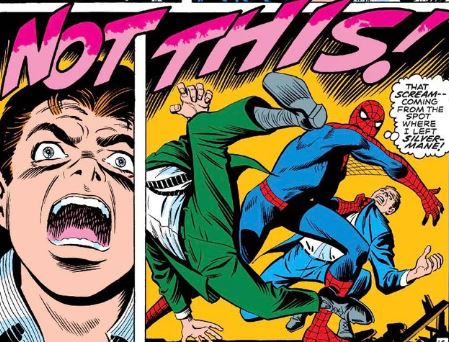
Amazing Spider-Man #73-75
Reading this I’m not shocked by Romita’s admission in the Marvel Masterworks intro that they were making it up as they went along. This three-parter hints at ongoing stories, and has a good set-up to a rematch with the Lizard, but it’s mainly about new characters caught in Spidey’s web. Silvermane, Man Mountain Marko and Cicero are not on the level of the Osborns or Dr Octopus, but they do feel lived in- as if they’ve had years of disputes and petty jealousy. This story elevated the Maggia- introduced in the Avengers- to a major force in the Marvel Universe. The regular title seems adrift given the lack of attention to anything to do with Peter Parker’s life, but that’s not as obvious since Spider-Man’s main adventure is compelling.
A-
Amazing Spider-Man #76-77
Romita’s not even the inker- the art is by the team of John Buscema and Jim Mooney, and there’s a reason they don’t make “best of” lists when ti comes to Spidey. An epilogue to the Tablet of Time, this two-parter is a generic Lizard story elevated by an okay twist. It’s 50 years old, but maybe it’s better if one or two people discover it for themselves and not on the back of a trading card like I did. It’s an okay story- imperfect but the A-plot has a decent complication for Connors, which adds drama even if it ends quickly.
B
Comics Read So Far From the List: 85/ 1,600Sincerely,
Thomas Mets
-
08-16-2023, 10:01 AM #9

It’s obviously a good list…but jeez it’s very, very focused on American comics.
Looking solely at British scene would argue that some 2000AD stuff ought to be on list…a few Judge Dredd progs, Alan Moore’s Time Twisters and Future Shocks, Grant Morrisons Zenith. (And..personal bias…something from Bryan Talbot like Adventures of Luther Arkwright.) And..of course…French comics scene is particularly vibrant.
-
08-16-2023, 01:43 PM #10
-
08-17-2023, 03:51 PM #11

It's almost twenty years old, and since then there's been a greater appreciation in American comics medium for British comics and FB comics, especially with better efforts by 2000AD and Humanoids and other publishers to get into the American market. It was also not meant to be a definitive list.
A Top 100 by Total Film/ SFX seems more up your alley.
In 91st place is Judge Dredd: The Cursed Earth.
In 87th place is Tank Girl.
In 81st place is Button Man- The Killing Game
In 76th place is Death Note.
In 74th place is Lone Wolf and Cub.
In 66th place is Judge Dredd: America.
In 62nd place is Dotter of Her Father's Eyes
In 54th place is Grandville.
In 48th place is Phonogram.
In 47 place is the Nao of Brown.
In 35th place is The Ballad of Halo Jones,
In 34th place is the Incal.
In 29th place is Tamara Drewe.
In 24th place is The Adventures of Luther Arkwright.
In 12 place is V For Vendetta (British comics known to American audiences like Moore's Miracleman, Morrison's The Invisibles and Gaiman/ McKee's Violent Cases popped up.)
In 11th place is Akira.
In 9th place is Alice in Sunderland.
Spider-Man is absent, which I don't care for. And frankly Tintin should be included (along with either Carl Barks Scrooge, or at least the Life and Times of Scrooge McDuck.) But it did expose me to Bryan Talbot.
The Comic Book Buyer's Guide list is also skewed in favor of back issues, rather than graphic novels, which may explain some exclusions.Sincerely,
Thomas Mets
-
08-18-2023, 02:03 AM #12

I realised it wasn't meant to be a definitive list (not sure how that would be possible)...but the narrow focus of it surprised me.
Talking of surprise..I know naff all about French comics, so just to while away 10 minutes googled "Great French comic series". I was surprised just how many best sellers in French market were actually created by Belgian artists.
-
08-18-2023, 07:02 AM #13
-
08-18-2023, 10:41 AM #14
-
08-18-2023, 10:42 AM #15




 Reply With Quote
Reply With Quote





